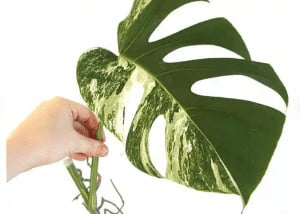What Is A Pebble Tray For Houseplants? (With Infographic)
-
Chris Dosser
- June 14, 2021
If you buy something using the retail links in our articles, sometimes we earn a small affiliate commission. This does not impact the products we recommend.
A pebble tray (also known as a humidity tray) is a tray filled with pebbles and water that help create an area of high humidity in the air surrounding any houseplants placed onto the pebbles.
In terms of caring for your indoor plants, using a pebble tray is about as simple as it gets yet the method can be really effective at improving the health of some tropical plants.
Why do plants care about humidity?
Humidity is a measure of the moisture content in the air.
Plants in their natural environment don’t always have ready access to water (or a human with a watering can), so they have to take what they can get to survive. One method of obtaining enough water to grow is for moisture to be extracted from the air by foliage.
This moisture isn’t always available in the atmosphere created by our homes, especially in winter when the cold temperatures of the air hold even less moisture.
The American Environmental Protection Agency recommends keeping the air in your house between 30% – 65% humidity to prevent viruses, bacteria and mites from thriving.
This low level of moisture in the air is fine for a desert dwelling plant such as cacti but not great for the leafy greens of a plant used to living in the humid understory of a tropical forest.

DIY: make your own pebble tray for indoor plants
It’s a straightforward process to create your very own pebble tray…
- To make your pebble tray choose a tray at least twice the width of the pot holding your plant
- Choose a type of pebble that is at least 10mm in size to allow gaps large enough for water to evaporate. Smaller medium such as gravels can trap water and cause mould to form
- Top up the water level in the tray regularly to just below the top of the pebbles.
What type of pebbles should I use for my pebble tray?
Here’s where you have a bit of a choice as almost any medium can be used to hold your plant pot above water. I’ve seen natural stone, terracotta balls and even stacks of poker chips work well in a pebble tray. It doesn’t really doesn’t matter as long as it doesn’t trap water and prevent it from evaporating into the air.
Personally with white and black office decor I’ve always favored the look of these polished black pebbles every time.
Are there alternative ways to increase humidity for plants?
Whilst pebble trays are a slow and steady passive method of creating high humidity around a plant there are several other ways simple ways to increase the humidity for plants:
Spray bottle. Glass bottles are more environmentally friendly when compared to plastic spray bottles. Keep one filled and next to your plant pot to make regular misting an easy task.
Plant Humidifiers. If you have a large number of plants a humidifier might work better to get around all of the foliage. Some of the better humidifiers quietly dispense water from a large reservoir and allow you to program in a desired humidity.

Chris Dosser
Co-Founder of Eden Indoors
Chris is a self-taught horticulturist with over a decade of experience caring for houseplants and creating lush, thriving indoor oases. He specializes in Monstera, and by self admission has a serious problem with buying and propagating rare indoor plants!
Similar Posts
9 Rare And Unusual House Plants For Sale On Etsy
This collection of stunning house plants are rarely found in garden centres or high street plant stores.
What To Do If Your ZZ Plant Has Exposed Root Bulbs?
An exposed root bulb above the soil of a ZZ plant is a concerning sight. Is it a dangerous sign of a rootbound plant, or is it harmless?



